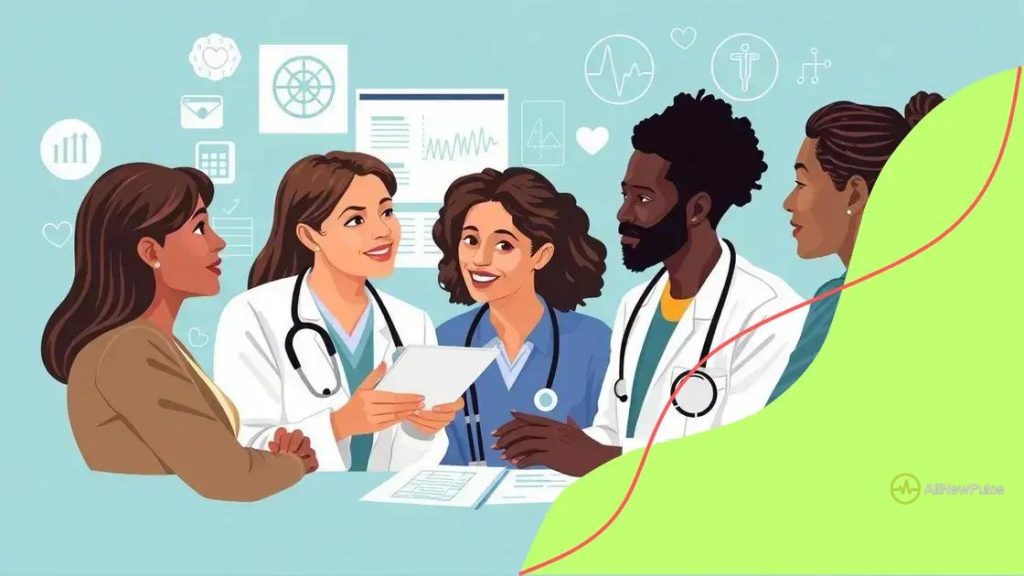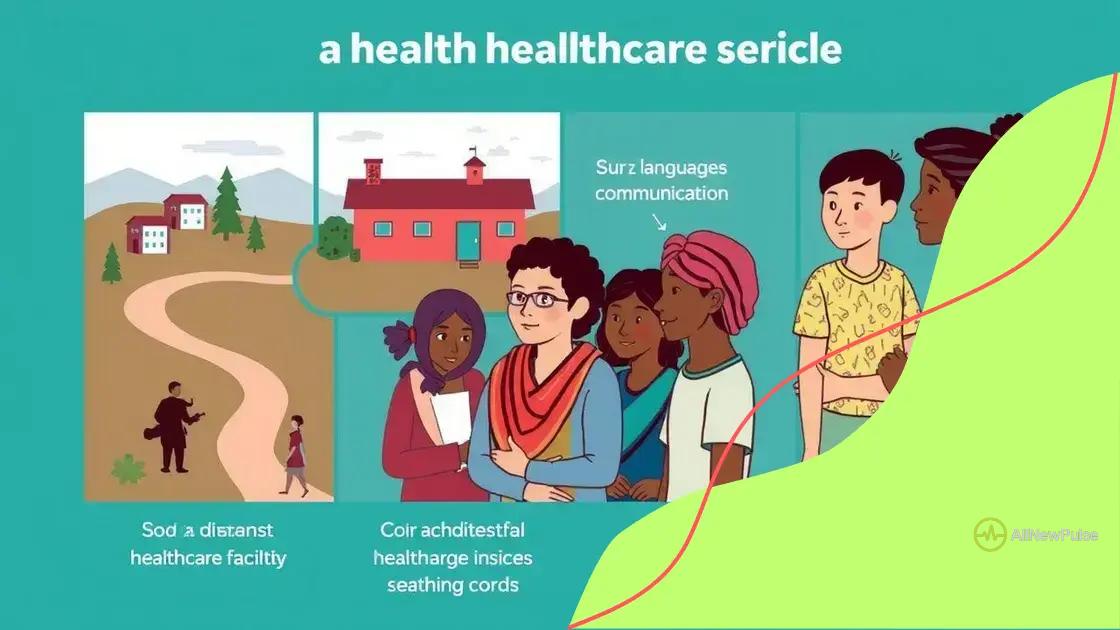Discussions on healthcare accessibility and affordability

Discussions on healthcare accessibility and affordability focus on addressing barriers to care, exploring innovative solutions like telehealth, and shaping a future where all individuals can access quality healthcare without financial strain.
Discussions on healthcare accessibility and affordability are becoming increasingly crucial as we navigate a complex landscape of medical services. With rising costs and varying access levels, it’s essential to explore what this means for everyone.
Understanding healthcare accessibility
Understanding healthcare accessibility is essential for ensuring that everyone receives the medical care they need. In this section, we will explore what healthcare accessibility means in today’s world and why it is crucial for individuals and communities.
What Is Healthcare Accessibility?
Healthcare accessibility refers to the ease with which individuals can obtain necessary medical services. It encompasses various aspects, including geographical availability, affordability, and the ability to receive timely care. When looking at this topic, we must consider how these factors affect overall health outcomes.
Factors Affecting Accessibility
- Location: Proximity to healthcare facilities can hinder or enhance access.
- Insurance Coverage: Affordability often depends on whether individuals have health insurance.
- Transportation: Reliable transport options can determine whether patients can attend appointments.
- Cultural and Language Barriers: These can prevent effective communication between providers and patients.
In addition to these factors, it’s important to acknowledge the role of socioeconomic status. Individuals from lower-income backgrounds often face greater challenges in accessing healthcare services, which can lead to disparities in health outcomes. This highlights the need for policies that address these inequities.
Furthermore, accessibility is not solely about physical locations. It also includes the availability of services like telehealth, which can significantly improve access for many. With technology advancing, more people can receive healthcare without needing to travel long distances.
In conclusion, understanding healthcare accessibility helps us recognize the barriers that prevent individuals from getting the care they need. By addressing these issues, we can work towards a more equitable healthcare system that benefits everyone, regardless of their circumstances.
Importance of affordability in healthcare
The importance of affordability in healthcare cannot be overstated. When medical services are too expensive, many people struggle to get the care they need, leading to worse health outcomes and increased suffering.
What Makes Healthcare Affordable?
Affordability in healthcare means that individuals can access necessary services without financial strain. This includes the cost of appointments, treatments, medications, and insurance premiums. When any of these elements are too high, people may avoid seeking care or skip essential treatments.
Consequences of High Healthcare Costs
- Delayed Care: Many patients postpone visits to doctors due to cost, which can lead to worsening conditions.
- Increased Emergency Visits: Those unable to afford routine care may resort to emergency services, which are more expensive.
- Financial Stress: High medical bills can lead to significant financial burdens on families.
- Health Disparities: Low-income communities often face greater challenges accessing affordable healthcare.
By making healthcare more affordable, we improve overall public health. When individuals can access care without fear of financial ruin, they are likely to seek preventative treatments. This proactive approach can lead to healthier communities and lower costs in the long run.
Additionally, programs that focus on making medicines affordable have demonstrated success in reducing health disparities. For instance, initiatives that provide generic medications can significantly lower costs for patients, making treatments more accessible.
In conclusion, ensuring that healthcare is affordable is vital for the wellbeing of individuals and societies as a whole. It allows people to prioritize their health without facing overwhelming financial pressure.
Challenges faced in achieving accessibility

Challenges faced in achieving healthcare accessibility are significant and complex. Many individuals encounter various barriers that prevent them from receiving the care they need, leading to poorer health outcomes.
Types of Barriers to Accessibility
These barriers can be categorized into several key areas. Understanding these challenges helps us identify the solutions needed to improve healthcare access for everyone.
- Geographic Barriers: In rural areas, healthcare facilities may be far away, making it difficult for patients to travel for treatment.
- Financial Barriers: High costs of care and lack of insurance are major obstacles that prevent people from seeking necessary medical attention.
- Language and Cultural Barriers: Patients from diverse backgrounds may struggle to communicate effectively with healthcare providers, leading to misunderstandings.
- Systemic Issues: Policy and infrastructure failures can hinder access to care. For example, shortages of medical professionals in specific regions can limit service availability.
Efforts to increase accessibility often face resistance due to a lack of awareness and understanding of these issues. For instance, some policymakers may not recognize the severity of geographic barriers in healthcare. This can lead to inadequate funding or resources allocated to address these disparities.
Additionally, the stigma surrounding certain health conditions may prevent individuals from seeking care. People might avoid going to a clinic or hospital due to fear of judgment or discrimination. This is especially true for mental health services, where cultural stigma can be a significant barrier.
These challenges emphasize the need for comprehensive policies that aim to enhance accessibility throughout the healthcare system. By acknowledging and addressing these issues, we can create a more inclusive environment that promotes equitable care for all.
Innovative solutions for affordable care
Innovative solutions for affordable care are crucial in today’s healthcare landscape. As costs continue to rise, finding new approaches can help make healthcare accessible for everyone.
Telehealth Services
One promising solution is the rise of telehealth services. This technology allows patients to consult with healthcare providers from the comfort of their homes. Telehealth can save time and reduce costs associated with travel and in-person visits. It is especially beneficial for individuals in rural areas with limited access to healthcare facilities.
Sliding Scale Payment Models
- Income-Based Payments: Some clinics offer sliding scale fees based on a patient’s income, making it more affordable.
- Community Health Programs: These programs often provide services at reduced costs or even for free to those who qualify.
- Non-Profit Healthcare Organizations: Many non-profits focus on serving low-income populations by providing affordable care options.
Additionally, innovative technology is changing how care is delivered. Wearable devices monitor health metrics, allowing for preventive care and reducing the need for expensive interventions down the line. This can relieve pressure on healthcare systems and keep patients healthier overall.
Partnerships between government agencies and private companies are also fostering innovative solutions. For instance, initiatives that combine public funding with private innovation can lead to the development of new healthcare delivery models. These joint efforts often create more effective, cost-efficient services.
In summary, focusing on innovative solutions is key to making healthcare affordable. By embracing technology and creative payment models, we can improve accessibility for all individuals and achieve better health outcomes.
Future of healthcare systems
The future of healthcare systems is an exciting topic as technology and policies evolve. The landscape of healthcare is changing rapidly, with innovations that aim to improve accessibility, affordability, and overall patient care.
Technological Advancements
One significant aspect of the future is the integration of technology into healthcare. Telemedicine is becoming more common, allowing patients to consult healthcare providers remotely. This is especially beneficial for individuals in rural areas where access to services is limited. Moreover, artificial intelligence is being used to analyze patient data, leading to more accurate diagnoses and personalized treatment plans.
Patient-Centered Care
- Increased Focus on Preventative Care: Future systems will likely prioritize prevention to reduce long-term healthcare costs.
- Personalized Medicine: With genetic testing and data analysis, treatments can be tailored to individual patients.
- Enhanced Patient Engagement: Patients will have more access to their health information and tools to manage their own care.
The shift towards a more patient-centered approach means healthcare systems will need to be flexible and responsive. Providers will be encouraged to adapt to patient needs and preferences. This includes offering a range of services that meet diverse cultural and linguistic requirements.
Additionally, the collaboration between different stakeholders in healthcare will play a crucial role. Partnerships among governments, private enterprises, and non-profits can lead to innovative solutions that enhance access to care. By pooling resources and expertise, these collaborations can address systemic issues and create more equitable systems.
In summary, the future of healthcare systems is geared towards leveraging technology to improve access and outcomes. By focusing on prevention, personalized care, and collaboration, we can expect a healthcare landscape that is more inclusive and effective for all.
FAQ – Questions about Healthcare Accessibility and Affordability
Why is healthcare accessibility important?
Healthcare accessibility is crucial because it ensures that everyone can obtain necessary medical services, leading to better health outcomes.
What are some innovative solutions for affordable healthcare?
Innovative solutions include telehealth services, sliding scale payment models, and community health programs that offer reduced fees.
What challenges do people face in accessing healthcare?
Challenges include geographic barriers, high costs, insurance issues, and language or cultural differences that hinder effective communication.
What does the future of healthcare systems look like?
The future of healthcare systems is focused on leveraging technology, promoting patient-centered care, and fostering collaborations to improve access and affordability.





